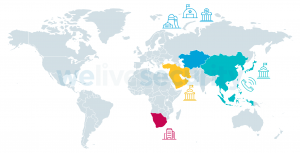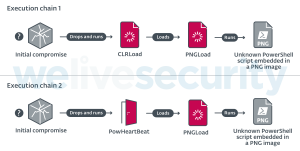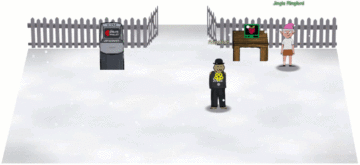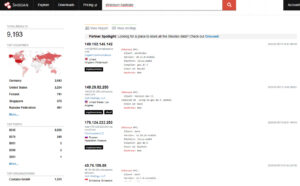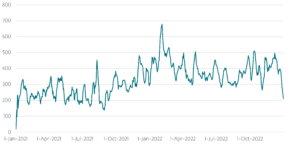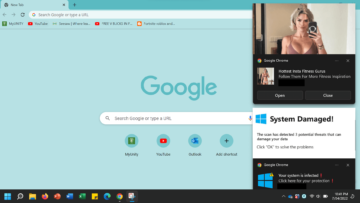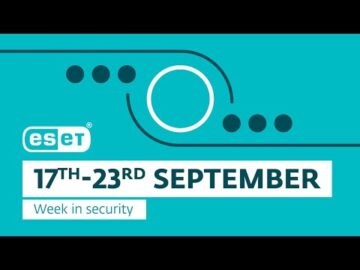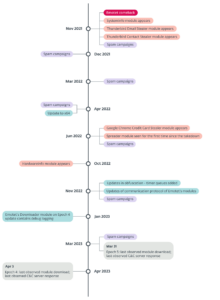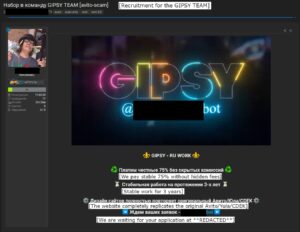Focused mostly on Asia, this new cyberespionage group uses undocumented tools, including steganographically extracting PowerShell payloads from PNG files
ESET researchers recently found targeted attacks that used undocumented tools against various high-profile companies and local governments mostly in Asia. These attacks were conducted by a previously unknown espionage group that we have named Worok and that has been active since at least 2020. Worok’s toolset includes a C++ loader CLRLoad, a PowerShell backdoor PowHeartBeat, and a C# loader PNGLoad that uses steganography to extract hidden malicious payloads from PNG files.
Who is Worok?
During the ProxyShell (CVE-2021-34523) vulnerability disclosure in early 2021, we observed activity from various APT groups. One exhibited characteristics common with TA428:
- Activity times
- Targeted verticals
- Usage of ShadowPad
The rest of the toolset is very different: for example, TA428 took part in the Able Desktop compromise in 2020. We consider that the links are not strong enough to consider Worok to be the same group as TA428, but the two groups might share tools and have common interests. We decided to create a cluster and named it Worok. The name was chosen after a mutex in a loader used by the group. Further activity with variants of the same tools was then linked to this group. According to ESET’s telemetry, Worok has been active since late 2020 and continues to be active as of this writing.
Back in late 2020, Worok was targeting governments and companies in multiple countries, specifically:
- A telecommunications company in East Asia
- A bank in Central Asia
- A maritime industry company in Southeast Asia
- A government entity in The Middle East
- A private company in southern Africa
There was a significant break in observed operations from 2021-05 to 2022-01, but Worok activity returned in 2022-02, targeting:
- An energy company in Central Asia
- A public sector entity in Southeast Asia
Figure 1 presents a visual heatmap of the targeted regions and verticals.
Considering the targets’ profiles and the tools we’ve seen deployed against these victims, we think Worok’s main objective is to steal information.
Tehnična analiza
While the majority of initial accesses are unknown, in some cases through 2021 and 2022 we have seen exploits used against the ProxyShell vulnerabilities. In such cases, typically webshells have been uploaded after exploiting these vulnerabilities, in order to provide persistence in the victim’s network. Then the operators used various implants to gain further capabilities.
Once access had been acquired, the operators deployed multiple, publicly available tools for reconnaissance, including Mimikatz, EarthWorm, ReGeorgin NBTscan, and then deployed their custom implants: a first-stage loader, followed by a second stage .NET loader (PNGLoad). Unfortunately, we have not able to retrieve any of the final payloads. In 2021, the first-stage loader was a CLR assembly (CLRLoad), while in 2022 it has been replaced, in most cases, by a full-featured PowerShell backdoor (PowHeartBeat) – both execution chains are depicted in Figure 2. These three tools are described in detail in the following subsections.
CLRLoad: CLR assembly loader
CLRLoad is a generic Windows PE that we have seen in both 32-and 64-bit versions. It is a loader written in C++ that loads the next stage (PNGLoad), which must be a Common Language Runtime (CLR) assembly DLL file. That code is loaded from a file located on disk in a legitimate directory, presumably to mislead victims or incident responders into thinking it is legitimate software.
Some CLRLoad samples start by decoding the full path of the file whose content they will load as the next stage. These file paths are encoded with a single-byte XOR, with a different key in every sample. Decoded or cleartext, these file paths are absolute, with the following being those we have encountered:
- C:Program FilesVMwareVMware ToolsVMware VGAuthxsec_1_5.dll
- C:Program FilesUltraViewermsvbvm80.dll
- C:Program FilesInternet ExplorerJsprofile.dll
- C:Program FilesWinRarRarExtMgt.dll
- C:Program Files (x86)Foxit SoftwareFoxit Readerlucenelib.dll
Next, a mutex is created and we’ve seen a different name in every sample. The loader checks for this mutex; if found, it exits, because the loader is already running. In one of the samples, the mutex Wo0r0KGWhYGO was encountered, which gave the group its name of Worok.
CLRLoad then loads a CLR assembly from the possibly decoded file path. As unmanaged code, CLRLoad achieves this via CorBindToRuntimeEx Windows API calls in 32-bit variants, or CLRCreateInstance calls in 64-bit variants.
PowHeartBeat: PowerShell backdoor
PowHeartBeat is a full-featured backdoor written in PowerShell, obfuscated using various techniques such as compression, encoding, and encryption. Based on ESET telemetry, we believe PowHeartBeat replaced CLRLoad in more recent Worok campaigns as the tool used to launch PNGLoad.
The first layer of the backdoor code consists of multiple chunks of base64-encoded PowerShell code. Once the payload is reconstructed, it is executed via IEX. Once decoded, another layer of obfuscated code is executed, which we can see in Figure 3.
The second layer of the backdoor first base64 decodes the next layer of its code, which is then decrypted with Trojni DES (CBC mode). After decryption, this code is decompressed using the gzip algorithm, thus giving the third layer of PowerShell code, which is the actual backdoor. It is divided into two main parts: configuration, and handling backdoor commands.
The main layer of backdoor code is also written in PowerShell and uses HTTP or ICMP to communicate with the C&C server. It works as depicted in Figure 4.
konfiguracija
The configuration contains multiple fields, including version number, optional proxy configuration, and C&C address. Table 1 describes the meanings of the configuration fields in the different versions we have observed.
Table 1. Configuration field meanings
| Ime polja | Opis |
|---|---|
| nouse / ikuyrtydyfg (other samples) |
Neuporabljeno. |
| ClientId | Client identifier, used for the following purposes: · As a value when constructing the Glava piškotka for C&C communications. · As a cryptographic artifact for sent data encryption. |
| različica | Version number of PowHeartBeat. |
| ExecTimes | Number of allowed execution attempts when issuing a RunCmd (command running) command. |
| Uporabniški agent | User agent used for C&C communications. |
| referer | referer header used for C&C communications. |
| AcceptEncoding | Neuporabljeno. |
| CookieClientId CookieTaskId CookieTerminalId |
Values used to construct the Piškotek header for C&C communications. |
| UrlHttps | Protocol to use for C&C communications. |
| UrlDomain IP naslov Domene |
URL, domain(s), or IP address used as the C&C server. If Domene is not empty, it is chosen instead of IP naslov. V drugih primerih, IP naslov je zaseden. |
| UrlSendHeartBeat | URL path used when the backdoor asks the C&C server for commands. |
| UrlSendResult | URL path used when the backdoor sends the results of the command back to the C&C server. |
| GetUrl | Complete URL, used by PowHeartBeat to request commands from the C&C server. It is the concatenation of the URL elements above. |
| PutUrl | Enako kot GetUrl but used to send the results of the command back to the C&C server. |
| currentPath | Neuporabljeno. |
| ProxyEnableFlag | Flag indicating whether the backdoor must use a proxy or not in order to communicate with the C&C server. |
| Proxymsg | Address of the proxy to use if ProxyEnableFlag nastavljena na $true. |
| Interval | Time in seconds that the script sleeps for between GET requests. |
| BasicConfigPath | Path to an optional configuration file containing uptime, Izpad, DefaultIntervalin Domene. Those values will be overridden if the file is present. |
| uptime | Time of day from which the backdoor starts operating, meaning it starts making GET requests to the C&C server. |
| Izpad | Time of day until which the backdoor can operate, meaning the time when it stops making requests to the C&C server. |
| DomainIndex | Index of the current domain name to use for communications with the C&C server. In case a request returns an error message different from 304 (“Not modified”), DomainIndex se poveča. |
| SecretKey | Key used to decrypt/encrypt the configuration. Configuration is encrypted with multiple-byte XOR. |
| IfLog | Neuporabljeno. |
| IfLogFilePath | Flag indicating whether logging is enabled. |
| logpath | Path of the log file. |
| ProxyFile | File path of the optional proxy configuration. If it is empty or not found in the file system, the backdoor retrieves the user’s proxy settings from the registry value HKCUSoftwareMicrosoftWindowsCurrentVersionInternet SettingsProxyServer . |
| IfConfig | Flag indicating whether to use a configuration file. |
Figure 5 shows an example of the configuration extracted from a PowHeartBeat sample (SHA-1: 757ABA12D04FD1167528FDD107A441D11CD8C427).
|
1 2 3 4 5 6 7 8 9 10 11 12 13 14 15 16 17 18 19 20 21 22 23 24 25 26 27 28 29 30 31 32 33 34 |
$Script:nouse = 100; if(Test-Path $MyInvocation.MyCommand.Path){Remove-item $MyInvocation.MyCommand.Path -Force;} $Script:ClientId = “83”; $Script:Version = “2.1.3.0003”; $Script:ExecTimes = 10; $Script:UserAgent = “Mozilla/5.0 (Windows NT 10.0; WOW64) AppleWebKit/537.36 (KHTML, like Gecko) Chrome/69.0.3487.100 Safari/537.36”; $Script:Referer = “www.adobe.com”; $Script:AcceptEncoding = “text/html,app1ication/xhtml+xml,app1ication/xml;q=0.9,*/*;q=0.8”; $Script:CookieClientId = “s_ecid”; $Script:CookieTaskId = “aam_uuid”; $Script:CookieTerminalId = “AAMC_adobe_0”; $Script:UrlHttps = “http://”; $Script:UrlDomain= ” 118.193.78[.]22:443″; $Script:UrlSendHeartBeat = “/latest/AdobeMessagingClient.js”; $Script:UrlSendResult = “/content/dam/offers-homepage/homepage.jpg”; $Script:GetUrl = $Script:UrlHttps + $Script:UrlDomain + $Script:UrlSendHeartBeat; $Script:PutUrl = $Script:UrlHttps + $Script:UrlDomain + $Script:UrlSendResult; $Script:currentPath = Split-Path -Parent $MyInvocation.MyCommand.Definition; $Script:ProxyEnableFlag = $false; $Script:Proxymsg; $Script:Interval = 10 ; $Script:BasicConfigPath = “C:ProgramDataunins.dat”; $Script:UpTime = 0; $Script:DownTime = 24; $Script:Domains; $Script:DomainIndex; $Script:SecretKey = “###ConfigKey###”; #$Script:IfLog = $true; $Script:IfLogFilePath = “C:ProgramDatatpncp.dat”; $Script:logpath = “C:ProgramDataunins000.dat”; $Script:ProxyFile = “C:ProgramDatahwrenalm.dat”; $Script:IfConfig = $false; |
Figure 5. Configuration example
Šifriranje podatkov
PowHeartBeat encrypts logs and additional configuration file content.
Log file content is encrypted though multiple-byte XOR with a key specified in cleartext in the sample. Interestingly, clientId is used as a salt for the index into the key array. The key is a 256-byte array, which was identical in every sample that we encountered. Additional configuration file content is encrypted through multiple-byte XOR with the value from SecretKey as its key.
C&C communications
PowHeartBeat used HTTP for C&C communications until version 2.4, and then switched to ICMP. In both case the communication is not encrypted.
HTTP
In an infinite loop, the backdoor sends a GET request to the C&C server, asking for a command to issue. The encrypted answer is decrypted by the backdoor, which processes the command, and writes the command output to a file whose content is then sent to the C&C server via a POST request.
The format of the GET requests is the following:
|
GET <UrlSendHeartBeat> HTTP/1.1 User-Agent: <UserAgent> Referer: <Referer> Host: <Domain> Cookie: <CookieClientId>=<ClientId> Connection: close |
Note that the request is constructed using the eponymous configuration fields.
In the response from the C&C server, the third byte of the content is the command identifier that indicates the command to be processed by the backdoor. We’ll call it command_id. The remaining content of the response will be passed as an argument to the command that is processed. This content is encrypted with the algorithm shown in Figure 6, taskId being the value of the cookie named after CookieTaskId‘s value from the configuration.
|
1 2 3 4 5 6 7 8 9 10 |
o[int] $pos = $taskId % 256; for ($i = 0; $i -lt $tmpBytes.Value.Length; $i++) { $pos = $pos + $clientId; if ($pos -ge 256) { $pos = $pos % 256; } $tmpBytes.Value[$i] = [byte]($tmpBytes.Value[$i] -bxor $hexEnc[$pos]); } |
Figure 6. Requests content data encryption algorithm
The response from the C&C server also contains another cookie, whose name is specified by the backdoor’s CookieTerminalId configuration variable. The value of this cookie is repeated in the POST request from the backdoor, and it must not be empty. After executing the backdoor command, PowHeartBeat sends the result as a POST request to the C&C server. The result is sent as a file whose name is <command_id>.png.
ICMP
Starting from version 2.4 of PowHeartBeat, HTTP was replaced by ICMP, sent packets having a timeout of six seconds and being unfragmented. Communication through ICMP is most likely a way to evade detection.
There is no major change in versions 2.4 and later, but we noticed some modifications in the code:
- PowHeartBeat sends a heartbeat packet at each loop that contains the string ABCDEFGHIJKLMNOPQRSTU VWXYZ, before requesting a command. This informs the C&C server that the backdoor is ready to receive commands.
- Requests to get commands performed by the backdoor contain the string abcdefghijklmnop.
Heartbeat packets have the format described in Figure 7.
Razlika med ID stranke in client flag je to ID stranke differs in every sample whereas client flag is the same in every sample that uses ICMP. heartbeat flag indicates that the backdoor is sending a heartbeat. The response from the C&C server has the format described in Figure 8.
zastava here indicates whether there is a command to issue to the backdoor. Requests to get commands have the format described in Figure 9.
Note that the backdoor’s ICMP mode allows receiving an unlimited amount of data, divided into chunks, and the variables dolžino podatkov, Trenutni položaj in skupna dolžina are used to keep track of the transmitted data. Responses to these requests have the format described in Figure 10.
As in HTTP responses, the command identifier is the third byte of datum.
After seven consecutive ICMP replies with empty or inconsistently formatted content, transfers between the backdoor and C&C server are considered finished.
Concerning the requests to send the result of the issued command to the C&C server, server mode is changed for post mode, and the final string (abcdefghijklmnop) is changed for the result data.
Backdoor ukazi
PowHeartBeat has various capabilities, including command/process execution and file manipulation. Table 2 lists all commands supported by the various analyzed samples.
Table 2. PowHeartBeat command descriptions
| Ime | Command Identifier | Opis |
|---|---|---|
| Cmd | 0x02 | Execute a PowerShell command. |
| exe | 0x04 | Execute a command as a Postopek. |
| FileUpload | 0x06 | Upload a file to the victim machine. File content is gzip-compressed. |
| FileDownLoad | 0x08 | Download a file from the victim machine, and return file path, file length, creation time, access times, and file content to the C&C server. |
| FileView | 0x0A | Get file information of a specific directory, in particular: · Filenames · File attributes · Last write times · File contents |
| FileDelete | 0x0C | Izbrišite datoteko. |
| FileRename | 0x0E | Rename or move a file. |
| ChangeDir | 0x10 | Change the current working location of the backdoor. |
| Informacije | 0x12 | Get a category of information according to the specified argument: · “Basic information”: ClientId, različica, host name, IP addresses, explorer.exe version and size information, OS (architecture and flag indicating if the machine is a server), Interval, current directory, drive information (name, type, free space and total size), current time · “Time-Interval information”: Interval and current time · “Domain information”: decrypted configuration file content |
| config | 0x14 | Update the configuration file content and reload the configuration. |
| N / A | 0x63 | Backdoor exit. |
In case of errors on the backdoor side, the backdoor uses a specific command identifier 0x00 in the POST request to the C&C server, thus indicating an error occurred.
Note that before sending the information back to the C&C server, the data is gzip-compressed.
PNGLoad: Steganographic loader
PNGLoad is the second-stage payload deployed by Worok on compromised systems and, according to ESET telemetry, loaded either by CLRLoad or PowHeartBeat. While we don’t see any code in PowHeartBeat that directly loads PNGLoad, the backdoor has the capabilities to download and execute additional payloads from the C&C server, which is likely how the attackers have deployed PNGLoad on systems compromised with PowHeartBeat. PNGLoad is a loader that uses bytes from PNG files to create a payload to execute. It is a 64-bit .NET executable – obfuscated with .NET Reactor – that masquerades as legitimate software. For example, Figure 11 shows the CLR headers of a sample masquerading as a WinRAR DLL.
Once deobfuscated, only one class is present. In this class, there is a MainPath attribute containing the directory path the backdoor searches, including its subdirectories, for files with a . PNG extension, as shown in Figure 12.
vsak . PNG file located by this search of MainPath is then checked for steganographically embedded content. First, the least-significant bit of each pixel’s R (red), G (green), B (blue), and A (alpha) values are fetched and assembled into a buffer. Should the first eight bytes of that buffer match the magic number seen in Figure 13 and the next eight-byte value, control, be non-null, the file passes PNGLoad’s steganographic content check. For such files, processing continues with the remainder of the buffer decrypted with a multiple-byte XOR, using the key stored in PNGLoad’s SecretKeyBytes attribute, and then the decrypted buffer is gzip-decompressed. The result is expected to be a PowerShell script, which is run immediately.
Interestingly, operations performed by PNGLoad are logged in a file whose path is stored in the variable LogFilePath. Operations are only logged if a file is present whose path is specified by the internal variable IfLogFilePath.
We have not been able to obtain a sample . PNG file used along with PNGLoad, but the way PNGLoad operates suggests that it should work with valid PNG files. To hide the malicious payload, Worok uses Bitmap objects in C#, which only take pixel information from files, not the file metadata. This means that Worok can hide its malicious payloads in valid, innocuous-looking PNG images and thus hide in plain sight.
zaključek
Worok is a cyberespionage group that develops its own tools, as well as leveraging existing tools, to compromise its targets. Stealing information from their victims is what we believe the operators are after because they focus on high-profile entities in Asia and Africa, targeting various sectors, both private and public, but with a specific emphasis on government entities. Activity times and toolset indicate possible ties with TA428, but we make this assessment with low confidence. Their custom toolset includes two loaders – one in C++ and one in C# .NET – and one PowerShell backdoor. While our visibility is limited, we hope that shedding light on this group will encourage other researchers to share information about this group.
ESET Research zdaj ponuja tudi zasebna obveščevalna poročila APT in vire podatkov. Za vsa vprašanja o tej storitvi obiščite ESET Threat Intelligence stran.
IOC
datoteke
| SHA-1 | Ime datoteke | ESET Detection name | komentar |
|---|---|---|---|
| 3A47185D0735CDECF4C7C2299EB18401BFB328D5 | script | PowerShell/PowHeartBeat.B | PowHeartBeat 2.4.3.0003. |
| 27ABB54A858AD1C1FF2863913BDA698D184E180D | script | PowerShell/PowHeartBeat.A | PowHeartBeat 2.4.3.0003. |
| 678A131A9E932B9436241402D9727AA7D06A87E3 | script | PowerShell/PowHeartBeat.B | PowHeartBeat 2.4.3.0003. |
| 757ABA12D04FD1167528FDD107A441D11CD8C427 | script | PowerShell/PowHeartBeat.B | PowHeartBeat 2.1.3.0003. |
| 54700A48D934676FC698675B4CA5F712C0373188 | script | PowerShell/PowHeartBeat.A | PowHeartBeat 1.1.3.0002. |
| C2F53C138CB1B87D8FC9253A7088DB30B25389AF | script | PowerShell/PowHeartBeat.A | PowHeartBeat 1.1.3.0002. |
| C2F1954DE11F72A46A4E823DE767210A3743B205 | tmp.ps1 | PowerShell/PowHeartBeat.B | PowHeartBeat 2.4.3.0004. |
| CE430A27DF87A6952D732B4562A7C23BEF4602D1 | tmp.ps1 | PowerShell/PowHeartBeat.A | PowHeartBeat 2.1.3.0004. |
| EDE5AB2B94BA85F28D5EE22656958E4ECD77B6FF | script | PowerShell/PowHeartBeat.A | PowHeartBeat 2.4.3.0003. |
| 4721EEBA13535D1EE98654EFCE6B43B778F13126 | vix64.dll | MSIL/PNGLoader.A | PNGLoader. |
| 728A6CB7A150141B4250659CF853F39BFDB7A46C | RarExtMgt.dll | MSIL/PNGLoader.A | PNGLoader. |
| 864E55749D28036704B6EA66555A86527E02AF4A | Jsprofile.dll | MSIL/PNGLoader.A | PNGLoader. |
| 8DA6387F30C584B5FD3694A99EC066784209CA4C | vssxml.dll | MSIL/PNGLoader.A | PNGLoader. |
| AA60FB4293530FBFF00D200C0D44EEB1A17B1C76 | xsec_1_5.dll | MSIL/PNGLoader.A | PNGLoader. |
| B2EAEC695DD8BB518C7E24C4F37A08344D6975BE | MSVBVM80.DLL | MSIL/PNGLoader.A | PNGLoader. |
| CDB6B1CAFEE098615508F107814179DEAED1EBCF | lucenelib.dll | MSIL/PNGLoader.A | PNGLoader. |
| 4F9A43E6CF37FF20AE96E564C93898FDA6787F7D | vsstrace.dll | Win64/CLRLoad.C | CLRLoad. |
| F181E87B0CD6AA4575FD51B9F868CA7B27240610 | ncrypt.dll | Win32/CLRLoad.A | CLRLoad. |
| 4CCF0386BDE80C339EFE0CC734CB497E0B08049C | ncrypt.dll | Win32/CLRLoad.A | CLRLoad. |
| 5CFC0D776AF023DCFE8EDED5CADA03C6D7F9C244 | wlbsctrl.dll | Win64/CLRLoad.E | CLRLoad. |
| 05F19EBF6D46576144276090CC113C6AB8CCEC08 | wlbsctrl.dll | Win32/CLRLoad.A | CLRLoad. |
| A5D548543D3C3037DA67DC0DA47214B2C2B15864 | secur32.dll | Win64/CLRLoad.H | CLRLoad. |
| CBF42DCAF579AF7E6055237E524C0F30507090F3 | dbghelp.dll | Win64/CLRLoad.C | CLRLoad. |
Poti datotek
Vsaka MainPath, LogFilePath in IfLogFilePath values that we encountered in PNGLoad samples:
| MainPath | LogFilePath | IfLogFilePath |
|---|---|---|
| C:Program FilesVMwareVMware Tools | C:Program FilesVMwareVMware ToolsVMware VGAuthreadme.txt | C:Program FilesVMwareVMware ToolsVMware VGAuthVMWSU_V1_1.dll |
| C:Program FilesWinRar | C:Program FilesWinRarrarinstall.log | C:Program FilesWinRardes.dat |
| C:Program FilesUltraViewer | C:Program FilesUltraViewerCopyRights.dat | C:Program FilesUltraVieweruvcr.dll |
mreža
| Domena | IP |
|---|---|
| Noben | 118.193.78[.]22 |
| Noben | 118.193.78[.]57 |
| airplane.travel-commercials[.]agency | 5.183.101[.]9 |
| central.suhypercloud[.]org | 45.77.36[.]243 |
Muteksi
In CLRLoad samples, the mutex names that we encountered are:
aB82UduGX0EX
ad8TbUIZl5Ga
Mr2PJVxbIBD4
oERiQtKLgPgK
U37uxsCsA4Xm
Wo0r0KGWhYGO
xBUjQR2vxYTz
zYCLBWekRX3t
3c3401ad-e77d-4142-8db5-8eb5483d7e41
9xvzMsaWqxMy
Obsežen seznam indikatorjev ogroženosti (IoC) in vzorcev lahko najdete v naš GitHub repozitorij.
Tehnike MITER ATT&CK
Ta tabela je bila izdelana z uporabo različica 11 okvira MITER ATT&CK.
| Taktika | ID | Ime | Opis |
|---|---|---|---|
| Izviđanje | T1592.002 | Zberite podatke o gostitelju žrtve: programska oprema | PowHeartBeat gathers explorer.exe’s informacije. |
| T1592.001 | Zberite podatke o gostitelju žrtve: strojna oprema | PowHeartBeat gathers information about drives. | |
| T1590.005 | Zberite podatke o omrežju žrtve: naslovi IP | PowHeartBeat gathers IP addresses of the compromised computer. | |
| Razvoj virov | T1583.004 | Pridobite infrastrukturo: strežnik | Worok uses its own C&C servers. |
| T1588.002 | Pridobite zmogljivosti: orodje | Worok deployed multiple publicly available tools on the compromised machines. | |
| T1583.001 | Pridobite infrastrukturo: Domene | Worok has registered domains to facilitate C&C communication and staging. | |
| T1588.005 | Pridobite zmogljivosti: podvigi | Worok has used the ProxyShell vulnerability. | |
| T1587.001 | Razviti zmogljivosti: zlonamerna programska oprema | Worok has developed its own malware: CLRLoad, PNGLoad, PowHeartBeat. | |
| T1587.003 | Razvijte zmogljivosti: digitalna potrdila | Worok has created Let’s Encrypt SSL certificates in order to enable mutual TLS authentication for malware. | |
| Izvedba | T1059.001 | Tolmač ukazov in skriptov: PowerShell | PowHeartBeat is written in PowerShell. |
| Vztrajnost | T1505.003 | Server Software Component: Web Shell | Worok uses the webshell ReGeorg. |
| Izmikanje obrambi | T1140 | Razmegljevanje/dekodiranje datotek ali informacij | Worok uses various custom XOR-based schemes to encrypt strings and logs in PowHeartBeat, PNGLoad, and CLRLoad. |
| T1036.005 | Prikrivanje: ujemanje z zakonitim imenom ali lokacijo | PNGLoad samples are deployed in legitimate-looking VMWare directories. | |
| Dostop s poverilnicami | T1003.001 | Izpis poverilnice OS: pomnilnik LSASS | Worok uses Mimikatz to dump credentials from LSASS memory. |
| Discovery | T1082 | Odkrivanje sistemskih informacij | PowHeartBeat gathers OS information. |
| T1083 | Odkrivanje datotek in imenikov | PowHeartBeat can list files and directories. | |
| T1046 | Network Service Discovery | Worok uses NbtScan to obtain network information on compromised machines. | |
| T1124 | Odkrivanje sistemskega časa | PowHeartBeat gathers the victim’s time information. | |
| Collection | T1005 | Podatki iz lokalnega sistema | PowHeartBeat gathers data from the local system. |
| T1560.002 | Arhiviraj zbrane podatke: arhiviraj prek knjižnice | PowHeartBeat gzip-compresses data before sending it to the C&C server. | |
| Poveljevanje in nadzor | T1071.001 | Protokol aplikacijskega sloja: spletni protokoli | Some PowHeartBeat variants use HTTP as the communication protocol with the C&C server. |
| T1090.001 | Proxy: Internal Proxy | PowHeartBeat handles proxy configuration on the victim’s machine. | |
| T1001.002 | Data Obfuscation: Steganography | PNGLoad extracts pixel values from . PNG files to reconstruct payloads. | |
| T1573.002 | Šifrirani kanal: Asimetrična kriptografija | PowHeartBeat handles HTTPS communications with the C&C server. | |
| T1095 | Protokol neaplikacijske plasti | Some PowHeartBeat variants use ICMP as the communication protocol with the C&C server. | |
| T1132.001 | Kodiranje podatkov: Standardno kodiranje | Worok uses XOR encoding in PowHeartBeat, and PNGLoad. | |
| T1132.002 | Kodiranje podatkov: nestandardno kodiranje | Worok uses XOR encoding algorithms that make use of an additional salt. | |
| Eksfiltracija | T1041 | Eksfiltracija preko kanala C2 | PowHeartBeat uses its C&C communication channel to exfiltrate information. |
- blockchain
- coingenius
- kriptokurrency denarnice
- kripto izmenjava
- kibernetska varnost
- cybercriminals
- Cybersecurity
- oddelek za domovinsko varnost
- digitalne denarnice
- ESET Raziskave
- požarni zid
- Kaspersky
- zlonamerna programska oprema
- Mccafee
- NexBLOC
- platon
- platon ai
- Platonova podatkovna inteligenca
- Igra Platon
- PlatoData
- platogaming
- VPN
- Živimo varnost
- spletna varnost
- zefirnet

